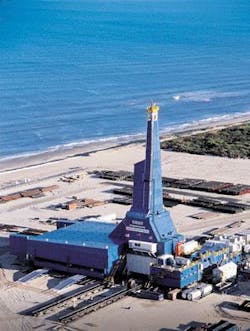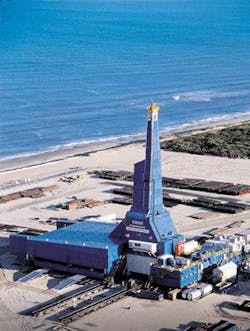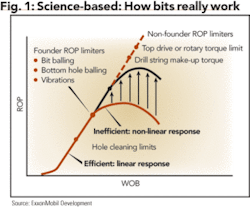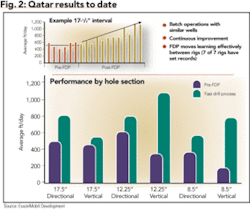Improving Drilling Efficiency
Don StowersEditor, OGFJ
Faster drilling changes the economic threshold for certain fields, reservoirs
As drilling costs soar, it behooves E&P companies to improve their efficiencies in order to maximize their rate of return on their investment - particularly when rig day rates are at an all-time high.
Exxon Mobil Corp. is among several oil and gas companies that have achieved impressive gains in drilling efficiency with what it calls its “fast drill process,” or FDP. The company tested the process in 2005 by drilling more than 500,000 feet of hole in a broad range of conditions in Qatar, Nigeria, Australia, Nova Scotia, South Texas, and Sakhalin Island.
In so doing, the company improved the rate of penetration (ROP) by 50% to 100% and cut total well times by as much as 35%.
“FDP is a new way of looking at drilling and workflow,” says Fred Dupriest, technical advisor, drilling technical, for ExxonMobil Development Co. “It’s a rig-based decision-making process. Half of the process is a new application of technology, and half is improving workflow efficiencies. FDP trains us to watch for inefficiencies.”
Traditionally, the focus has been on finding a better drill bit, says Dupriest. “The drill bit isn’t always the problem - how we use the bit is important,” he says. “For instance, we have learned that most impact damage to drill bits is due to vibration damage - not wear damage. Obviously we knew this was a problem, but we didn’t know the extent of it. Instead of needing a better bit, we found we needed a better hole-clearing process.”
M. W. (Mike) Krall, vice president, drilling, for EM Development, adds, “With FDP, you don’t just change bits - you re-engineer the whole system.”
Krall noted that FDP is the industry’s first comprehensive ROP design process that impacts all phases of planning and drilling activities. “MSE (mechanical specific energy) surveillance is used to illuminate ROP limitations in the drilling system and (watch for) the opportunity to drill faster,” he says.
Krall emphasizes that FDP is designed to drill faster - not work faster. “This is not about compromising safety,” he says. “To date, we haven’t had any accidents associated with the FDP.”
The optimization process developed by ExxonMobil achieves this breakthrough performance by using real-time, computer analysis of the drilling system’s energy consumption. This analysis, in turn, helps improve the management of the factors that determine drilling rate, such as weight on the drill bit, rotary speed, and torque. The result is significantly faster drilling rates and reduced downtime.
The company has used FDP in many of its operating areas, and the process improves performance in hard and soft rock, deep and shallow wells, high- and low-angle wells in a variety of mud weights. It has shown comparable success in exploration, delineation, and production wells, according to a company spokesman.
A key benefit of the FDP is that it quantifies the hidden cost of slow drilling. Drill rates have historically been evaluated by comparing performance to other wells in the same area. However, there has been no method to confirm that the comparison well was, itself, a high-performing well.
FDP allows ExxonMobil to make design changes to achieve the objective theoretical performance in a given well. Much of the performance improvement achieved comes from this ability to objectively justify design changes needed to extend previous performance limits.
“The FDP is the latest in a series of competitive, differentiating practices developed by ExxonMobil’s drilling organization to reduce costs and allow wells to be put on production faster than previously possible,” says Mark Albers, president of EM Development.
“With FDP, our drilling technical organization bridges the gap between science and operational practices to get the right technology in the hole,” he adds. “The team works with our operating group to make the connection between the engineering fundamentals and the real world of drilling wells. They identify the relevant science, create unique operating practices based on proven principles, and develop training processes to deploy these practices across our global organization as fast as possible.”
Collateral benefits of FDP include operating efficiencies from completing and cementing a quality well bore and more uniform bore-hole sizes, resulting in significant savings in operating tools.
Following FDP’s successful field testing, ExxonMobil plans to implement the proprietary process worldwide. To date, FDP has been implemented in about 50% of ExxonMobil’s worldwide drill teams, says Dupriest. He expects all wells to be drilled with this ROP design process by year-end 2006.
“We have 16 teams worldwide right now, including one US team, and we are about half done with implementation,” says Dupriest. “We work with each team to develop a tailored approach to their situation. We have outstanding people working for us, so we teach them how things work and then get the heck out of the way.”
This initiative follows several other recent advances by ExxonMobil, including worldwide deployment of fracture closure stress practices for managing lost returns in low-integrity formations, integrated hole quality and wellbore stability practices for drilling extended-reach wells, and the development of comprehensive deepwater completion practices.
ExxonMobil’s FDP process is but one example of major gains in drilling efficiency, says Oil & Gas Journal drilling editor Nina Rach, who believes 2006 will be a year of significant improvements.
“I expect to see record-breaking footage in fields around the world as operators begin to optimize their drilling operations by analyzing mechanical specific energy (MSE) and using MSE surveillance to eliminate bit inefficiencies,” she says. “This will change some of the assumptions in technical limit drilling.”
With regard to downhole vibration, which has been identified as a major bit-related problem and engineering challenge, Rach notes, “In February, Halliburton Co. will present results of a real-time downhole torsional vibration monitor. Kerr-McGee Corp. is using real-time pressure-while-drilling data to help optimize ROP and hole-cleaning. ExxonMobil is training hundreds of contractors in FDP, and the new approach is sure to trickle down through the industry.”$






